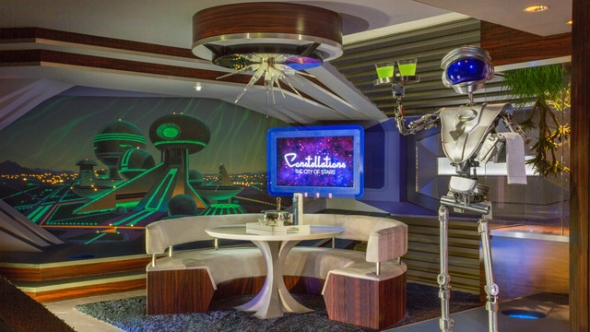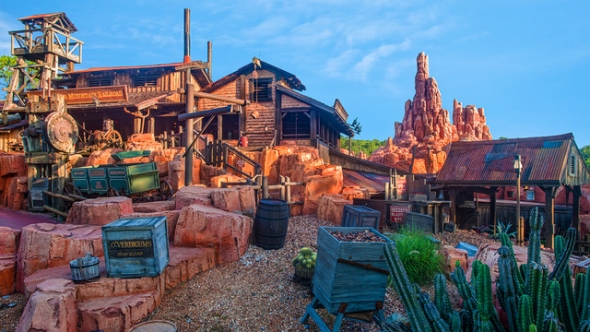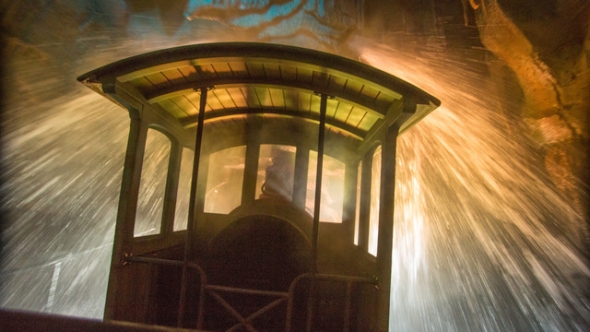Space Mountain
Image: Disney
From its original conception, Space Mountain was intended to be a modernized version of the Matterhorn Bobsleds. One of the reasons Disney hired Arrow in the first place was that they’d worked on Disneyland’s most famous roller coaster. The plans for Space Mountain were ambitious. It would contain four tracks that could depart the gate at the same time or at set intervals. Disney’s financial issues as well as the space limitations expected for Space Port at Tomorrowland eliminated the multi-track option. For this reason, the premise of Space Mountain briefly fell out of favor with park planners.
Rather than create a new ride, the company realized they could save money by duplicating Matterhorn Bobsleds at Walt Disney World. Hey, it’d worked with Pirates of the Caribbean, and thrill rides were proving especially popular with the insatiable Florida crowd. Eventually, Disney execs recognized that they were in danger of Walt Disney World becoming known as Disneyland East rather than having its own distinct identity. They returned to the original plan, which was a new and improved coaster concept rather than a throwback to one from 1955.
In order to make Space Mountain stand out as something especially unforgettable, Imagineers appreciated that they’d have to do something different. That drive to build something novel led to the man-made structure so closely associated with Space Mountain today. Disney knew that the one advantage of building it at Walt Disney World was that they’d have a great deal more space. Tomorrowland was relatively barren in its early days. The problem remained budgetary in nature. One of Disney’s top executives found a clever solution, enticing RCA to sponsor the ride in exchange for a $10 million investment. That was enough for Disney to feel comfortable greenlighting the $24 million project, out of which they would pay $14 million.
The exterior structure required a massive facility. Space Mountain would host the world’s first indoor space-themed roller coaster. To get the details right, the interior roofing would project the Earth’s place among the stars, thereby fostering the sensation of actual space travel. Gordon Cooper, one of the original seven NASA astronauts from Project Mercury worked as a special advisor to the project to lend an air of authenticity. Award-winning author Ray Bradbury also participated, since science fiction is oftentimes more stimulating than science fact.
The two men combined with Disney illustrators to build a blueprint for Space Mountain the building. They designed the amazing 183-foot structure, which fell only six feet short of matching Cinderella Castle in height. Space Mountain features a circular design that was hotly contested for a time. Some Imagineers preferred a dome shape while others favored a cone. The latter option eventually won.
To bring the blueprints to life, Disney needed 4,000 giant pieces of steel plus 12,000 feet of electrical wire. The project required less than two years to complete once Disney finally broke ground, although the opening date of January 15, 1975, was over a decade after the initial conceptualization and pitch. You can see some wonderful photographs of its construction here. After the Walt Disney World version of Space Mountain debuted, Disney immediately focused on transferring the ride back to Disneyland. On May 27, 1977, the California version opened. Between the two attractions, the company invested more than a million man-hours on design and construction. The Disneyland version cost $4 million less at $20 million.
Finally, there’s a mine ride
Image: Disney
Perhaps because they were fresh out of excuses, Disney finally moved forward on the long-gestating train roller coaster project once the Space Mountain build ended at Walt Disney World. Imagineers speculate that the delay turned out to be a net positive for the attraction. Computers evolved at an exponential rate during the 1970s. What was a nascent technology back when Tony Baxter invented the roller coaster train concept had advanced dramatically over the course of the decade.
Of course, there was still a Charlie Brown trying to kick the football element to the construction. Amusingly, Disney execs once again flipped the placement of Big Thunder Mountain Railroad. After years of discussion about its inevitable location at Magic Kingdom, Disney finally broke ground…at Disneyland. You’re likely noticing a pattern here.
The company played a shell game with all of their major projects during the 1970s. They followed a strict cost projection strategy based on where new rides would cost the least while bringing in the most new business. For whatever reason, Big Thunder Mountain Railroad at Walt Disney World lost this game so much that they would have picked #1 overall in the Phantom Disney Attractions Draft.
Finally, the next Magic Kingdom mountain arrives
Image: Disney
In September of 1979, the great train adventure finally debuted at Disneyland. Around the same time, Disney determined that they should host the ride at both locations a la Pirates of the Caribbean and Space Mountain. So, nearly a decade after its initial proposal, the last remnant of Western River Expedition finally came to fruition at Walt Disney World.
While not the skyscraper as some of the other attractions listed here, Big Thunder Mountain Railroad still stood 104 feet tall, more than Sleeping Beauty Castle at Disneyland. It again takes advantage of the ample Disney property in Florida, running over two-and-a-half acres of track, 25 percent more than its California counterpart. It includes a heavily sloped hillside that allows the coaster to turn at steep 270-degree angles while still delivering the experience of a runaway train during inclement weather. If you hadn’t realized this about the ride, you can read some odd trivia about its backstory here.
With regards to the details of that story, Big Thunder Mountain’s construction highlighted the conceit that this mid-19th century town had to be abandoned quickly. The end result left the mine trains somehow operating on their own. To reinforce the theme, Imagineers painted the mountain a reddish tinge to remind observers of the red rocks prevalent in the American southwest, one of the primary locations of gold rush settlers.
The next time you look at the mountain range, pay particular attention to the craftsmanship and attention to detail Disney demonstrated in crafting an artificial mountain so lifelike and vivid. Even as it stands next to another manmade façade, Splash Mountain, it still towers above the 87-foot tall structure close by. The twin towers have stood side by side since 1992, and it’s difficult to separate the two when thinking of Frontierland. Had fate not been so capricious with Big Thunder Mountain Railroad, however, it could have been connected to a much different boat ride instead. All in all, I think we’d all agree that the situation worked out for the best.




Comments
Good article.
What surprises me is how quickly the new attractions were constructed (after finally deciding, of course). We are now looking at 3+ years before Pandora is open to the public, and its likely Star Wars land won't be open for another 4 years. I know these are themed areas and not just a single attraction, but I would think advancements in construction technology would speed things up a bit.